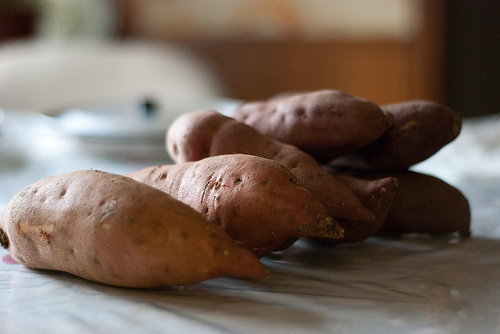savor
Mindful Eating, Mindful Life
savorthebook.com
Read More About
Mindful Eating
Mindful Living
Weight Loss
Exercise
Meditation
Yam or Sweet Potato? Recipes for the Holiday Favorite

When colder weather comes around, the yam or sweet potato becomes a popular food choice for warm and comforting meals. With the upcoming holidays, many might even deem their plates incomplete without its bright orange presence. Unfortunately, many common recipes overlook the vegetable's natural sweetness and add in sugar, syrups, or even marshmallow candy. Susan Guillory took a look into the rich history of the food, and developed some delicious recipes--from naturally sweet to savory--for your next gathering.
During a recent family reunion in Louisiana I re-discovered my state’s love of one of nature’s most nutritious and versatile foods, the yam or sweet potato. After much research, it is difficult to differentiate the two as the name is used interchangeably in the U.S. The actual yam is from originally from Africa and takes its name from the African word for “njam” which means “to eat.” It is an edible tuber from a tropical vine whereas the sweet potato is a member of the morning glory family.
My French ancestors were introduced to native sweet potatoes by the local Native American tribes like the Opelousas. A town was founded with that name and for the past 70 years has been home to the annual Yambilee Festival, to support the local agriculture business of yams. This indigenous plant is actually a sweet potato but is referred to colloquially as a “yam."
This vegetable has so many diverse uses that it can be somewhat of a mindful adventure to choose and use recipes or even better, make up your own. They can be boiled, mashed, baked, fried, stuffed, or used as a savory or dessert. My Cajun Grandfather always put a plain baked yam in the middle of his bowl of gumbo.
Whichever one of the many varieties of both the sweet potato or yam you use in your diet, you will always be treating yourself to key minerals like potassium, magnesium and phosphorus. You will come out ahead if you choose the morning glory family member, sweet potatoes, as they have larger amounts of Vitamin A, plus twice the protein of the tuber, yams.
While shopping in New Orleans’ new permanent farmer’s market and urban farm called Hollygrove, I was compelled to buy sweet potatoes from their new fall crop.
This is the recipe I developed for my extended family’s breakfast:
Sweet potato hash
Serves four
2 medium sweet potatoes or yams, peeled and chopped
1 small red onion, finely chopped
1 cup diced pineapple
4 habanero pepper slices (optional)
2 T vegetable oil of choice
1/2 cup water
Salt to taste
In one saucepan add water and sweet potatoes, bring to a boil then simmer for 15 minutes until soft. Add oil to a frying pan, then the onions and cook with low heat until totally cooked. Add pineapple and other ingredients with potatoes at the end. Stir well and often and cook until sweet potatoes are totally soft. Best served hot.
For lunch or dinner, a main course dish:
Yam Chili, Three Ways
Serves six
3 medium sweet potatoes or yams
1 medium onion, chopped finely
2 medium peppers of your choice (can be sweet, mild or hot and various colors), chopped finely
2 T vegetable oil
2 cloves garlic, chopped
1 T ground allspice
½ tsp. ground cumin
½ cup water
Salt to taste
This recipe is all about personal preference when it comes to the protein. You can use:
1 square of firm or extra firm tofu
1 package of tempeh, or
1 can of black beans.
-In advance if you choose to use tempeh, cut in bite size pieces and marinate for one hour or more with 2 T spoons of soy sauce and ¼ tsp., ground cumin and ½ T ground allspice in addition to the amount that will be used in the yam mixture.
-If using tofu, cut in bite size pieces and add 2 T soy sauce and marinate for 15 minutes.
To prepare:
In a saucepan cook the sweet potatoes as described in previous recipe. In another pan, cook the onions in the oil until translucent then add the spices and stir for a few seconds. Stir in all the other ingredients and cook at low heat, stirring often until done (about 10 minutes).
Combine the protein of choice, mix well then cook at low heat for another 10 minutes. The flavors meld best and “open” when chilies are left on stove or in oven for a long period of time but it is not necessary.
SAVOR: Mindful Eating, Mindful Life. Copyright © 2024 by Thich Nhat Hanh and Lilian Cheung. All Rights Reserved. Please review our terms of use
Website design
Mary Pomerantz Advertising




